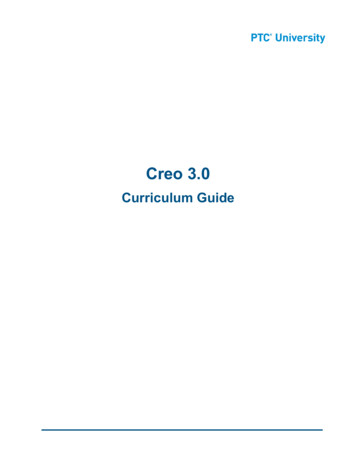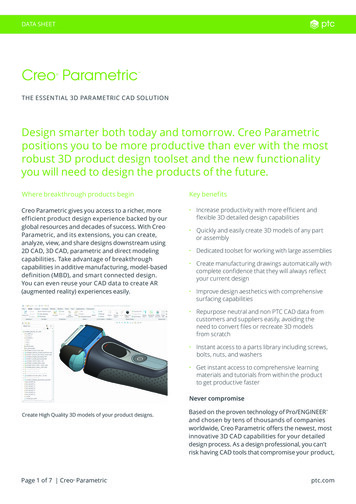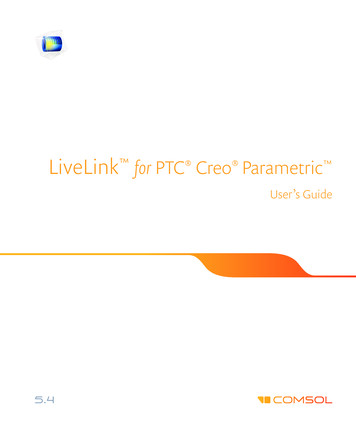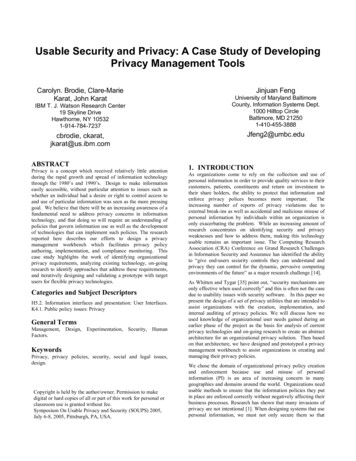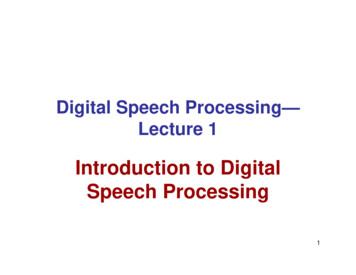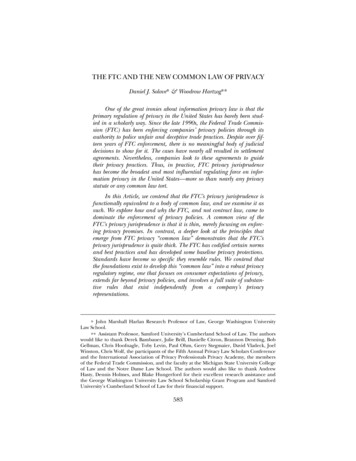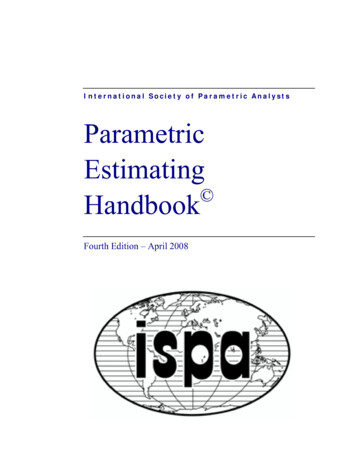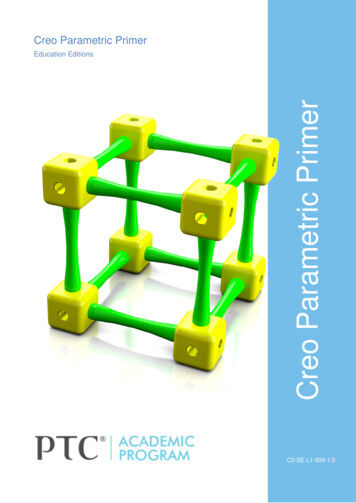
Transcription
Parametric study of speech privacy in semi-enclosed meeting podsPantea Alambeigi1, Jane Burry11Swinburne University of AbstractOverheard conversations are recognised as one of the most annoying sources of noise in the popular openplan layouts, which ends up in a lack of speech privacy and distraction. For addressing this problem, add-onmarket solutions are primarily reflectors and canopies installed in enclosed meeting pods or above fully openmeeting furniture which are heavily relied on acoustical properties of materials. Through developing assortedmatrices parametrically, this research identifies the governing geometric features of the canopies andreflectors in semi-enclosed meeting pods that impact speech privacy. Each solution was studied in anindividual matrix and simulations were run in ODEON to examine each variable separately. The collectiveoutcome offers preliminary design suggestions for improving speech privacy and implies that geometricdesign decisions can remarkably contribute to the auditory performance of the open interiors if consideredand integrated into the design at the preliminary stages of the workflow.Keywords: Parametric modelling, sound simulation, performance-driven design, speech privacy, integrateddesign1IntroductionQuite after the emergence of open plan working spaces, acoustical requirements were studied and defined tosustain employees’ well-being and organisational efficiency, and productivity. Multiple standards weredeveloped to establish a set of guidelines and methods to achieve the targets. However, in practice mostlikely the architectural design and the acoustical design are not integrated into a single workflow. Instead,with little to no exchange of information [1], acoustic experts are involved in most cases in the late stages ofthe design, or at the operational phase of the project [2]. In both scenarios, it is unlikely to modify thegeometry substantially [3]. Thus, minor changes in the design features primarily in the form of appendingnew elements with different materials are proposed which are costly and less effective [4,5]. Acknowledgingthe size, form, and materiality as the three influential architectural design principles reveals the strong mutualconnection between architecture and acoustics [6]. This implies that the soundscape is being formed from theonset of the design concept and it is deeply rooted in every design decision.The need for transformative steps to integrate architectural intervention in the acoustic design of workingspaces is now marked with greater reasons. End-user research and empirical studies in recent years showgrowing attention to the aesthetics of the working environments and furniture and demand for visuallyappealing design with adequate visual connection and a sense of privacy [7,17]. In addition, the recentmovement of performative architecture [8,9,10], supported by the advancement in CAD modelling and theemergence of parametric design, raised the question of how sound performance can become a form generatorat the conceptual stage. Parametric modelling and generative design with real-time simulation, analysis, andfeedback can countervail the shortfall of know-how knowledge of acoustics in architecture. However, despite1
this recent interest, still, the application of acoustic performance-based design is limited in practice [3,11].The use of sound absorption materials remains the popular solution to the acoustic problems of open planoffices [12], despite its failure in meeting the conflicting acoustic requirements of having speechintelligibility within a space and maintaining speech privacy between the spaces [6,13,14]. Applying a singlemethod of sound-absorbing surfaces seems insufficient to calibrate the acoustic performance. In the meetingspaces, absorbent materials decrease the reverberation time and increase the speech intelligibility within thespace, more often beyond necessity. Given the inverse relationship of speech intelligibility and speechprivacy [15,16], a crystal-clear conversation is more exposed to the risk of overhearing between the spaces.In small meeting rooms, since the major contributor to speech intelligibility is the direct sound [26], speechprivacy should become the priority of the design [13,17]. Therefore, an alternative to absorption has to beconsidered, that is to control the sound propagation by capturing the sound inside the space for a longerperiod until it is exhausted. Market-oriented cubic pods or furniture designed fully enclosed or widely openwith acoustic materials to absorb the sound fall short of taking this approach into account. Besides the pods,a wide range of clouds, canopies, baffles, and panels were also introduced by well-known industries such asHermann Miller Inc. Haworth, Steelcase, buzzispace, etc. including sound performative light pendants andfloating clouds and panels in various patterns such as pleated, gridded or 3D patterned and in multiple shapeswith or without holes. These products are mostly studied in literature and applied in practice for theirinfluence on the reverberation time of the open working environments and reducing the noise level whiletheir effect on speech privacy has not been fully addressed.2ObjectivesWhile in practice the acoustic design of the open plan workplaces is primarily leaning towards the soundproperties of the materials [12], the present paper proposes a new approach to control sound propagationwith the help of the geometry of the boundaries. Taking advantage of parametric modelling in producing aheterogeneous collection of iterations, this paper sheds light on the efficiency of a performance-drivenarchitectural design that improves the speech privacy of a meeting pod in addition to the materialconsideration.A semi-enclosed meeting pod with high partitions is studied as an appropriate solution to offset thedrawbacks of both extreme ends: low-partition pods or open meeting furniture that offer little to no privacyas opposed to the go-to default enclosed cocooning solutions that defy the open plan layout concept.While this paper is a continuum of series of investigations into the topic [13,18], it aims to analyse canopiesand reflectors in an integrated design as the two most sought-after approaches in the market for designingand retrofitting the open plan offices and meeting rooms.33.1MethodologyAnalysis parameter and modelling techniqueSpeech Transmission Index (STI), introduced in 1980 [19], is an objective indicator of the quality of thespeech transferred to the listener that can be applied to predict and measure speech intelligibility and speechprivacy [20]. Among all parameters of assessing speech privacy, STI, for its A-weighted filtering, is believedto be tied strongly to the human perception of speech privacy [21]. Therefore, it is selected as an objectivespeech privacy metric in this paper.The methodology developed for this study is a comparative analysis. Since sound performance is highlydependent on numerous interactive macro and micro spatial parameters, any trivial changes in the buildingenvironment including materiality, geometry, structure, furniture, occupancy, temperature, and humidity, etc.can cause a dramatic change. Therefore, in the interest of achieving some general conclusions in each matrixof study all parameters including materiality were kept constant. Iterations were generated with a parametrictool to ensure consistency in 3D modelling and to have absolute control over geometrical attributes such as2
volume, length, and angle which would be otherwise hard to govern. In addition, parametric tools can pushbeyond the limitations of the number of iterations that can be generated by traditional 3D modellingsoftware.All iterations were modelled in the Grasshopper, a parametric tool for the Rhinoceros 3D. A symmetricalcubic shape geometry was selected as the basis for the open plan office. The finished floor-to-ceiling heightis 3.3 metres with a total area of 900 square metres in the plan. The semi-enclosed pod is placed in the centrewith the consistent 50 cubic metres volume and the average volume-to-surface-area ratio of 1 metre. Thepartitions of the pod are extended up to 0.3 metres below the finished ceiling, allowing a 0.3 metres gapbetween the finished ceiling and the pod’s top edges. The pod in all simulations is hexagonal in plan, butwith three overall variations of convex, concave and flat surfaces. The symmetry in the pod and the openplan office was maintained in all iterations to minimise the effects of the mutual interaction of the pod andopen working environment on the acoustic performance of both spaces. However, the reciprocal relationshipbetween materiality and overall geometry was investigated, and more details on this can be found in previousstudies [13,18].3.2Sound simulation setupFew widely applied geometrical acoustic simulation tools are available including CATT-Acoustic, EASE,Pachyderm, Ansys, I-simpa, SoundPlan, etc. However, in this study, ODEON, a hybrid commercial roomacoustic software is selected as one of the most reliable and widely reviewed software in literature [22,23].Surfaces were assigned identical absorption coefficient values in all simulations as presented in Table 1. Thevalue of 0.05 was also given as a scattering coefficient to all surfaces.Table 1– Absorption coefficients of the pod and office surfacesFrequency 080.080.10Pod0.20.20.20.20.20.20.20.20.2The sound source was set in the centre of the pod at the average height of a seated person, 1.2 metres abovethe floor. The SPL values of the sound source applied in this study are listed in Table 2.ISO 3382-3 [20] recommendation for having an omnidirectional sound source was adopted in this study.However, since speech is inherently directional, a comparative simulation was performed to explore theoutcome differences if the real environment was about to be simulated.Figure 1 presents the STI maps with omnidirectional versus directional sound sources. It is observed thatexcept for the rear-facing positions which benefitted from more speech privacy, there is little to no differencein the speech privacy of the listening areas facing the speaker.Figure 1– STI maps with directional vs.omnidirectional sound source3
Table 2 – Omnidirectional sound source level applied in this study3.3Frequency (Hz)1252505001000200040008000SPL (dB)60.965.3696355.849.844.5Total powerTotal SPL at 10 m71.8 dB40.8 dB68.4 dBA37.4 dBAResults interpretationISO 3382-3 [20] suggests STI as the primary measure to evaluate speech privacy. However, there are slightdisagreements on the thresholds and definitions of speech privacy over the entire range from 0 to 1. ISO3382-3 [20] defines the privacy zone when STI drops below 0.2 and the distraction zone when STI is below0.5, whereas, in ISO 60268-16 [24], with STI above 0.75, there is no privacy and with STI below 0.6reasonable speech privacy is provided. The normal speech privacy in this standard is ranged from 0.3 to 0.45with excellent privacy in areas with STI below 0.3. In an experiment for exploring the human perception ofprivacy in a real environment, the threshold of 0.6 STI corresponded more to the subjective analysis of thenon-distracting areas with an acceptable level of privacy [25]. Therefore, in this study STI of 0.6 isconsidered the borderline of having an acceptable level of speech privacy.44.1Results and DiscussionMatrix A: Suspended ceiling with partial coverageOverhead canopies are extensively applied in open plan offices to create micro soundscapes in areas whereconversations are likely to happen. They come in various shapes and patterns and they can function as bothsound absorbers and light pendants. They are mostly applied to absorb the sound and decrease the RT value.However, for semi-enclosed meeting pods with high partitions, further study is required to investigate theimpact of suspended canopies on improving speech privacy. Two types of canopies are simulated in thisstudy (Figure 2) each in combination with three pods varied in section: Flat, convex, and concave pods.Figure 2 – Two approaches forpartially covering the ceiling, donutstyle and suspended central canopyIn Figure 3, expectedly, it is illustrated that as the size of the suspended central canopy gets smaller and thegap between canopy and pod widens the STI increases in all three types of the pod. However, interestinglythe matrix indicates that the impact of a central canopy on both concave and flat pod counters the significantSTI improvement that the central canopy brings to the convex pod. This implies the effectiveness of adoptinga central canopy just over a convex pod. While in a convex pod with no overhead canopy only 0.5% of theoffice area has STI below 0.6, this figure soars to 41% when the void between the pod’s top edges andcanopy’s edge is 50 cm. When the canopy shrinks and the gap starts to open up the percentage of areas withSTI under 0.6 falls quickly to 17% with only a 20 centimetres increase in the gap. With a metre distancebetween the edges of the canopy and pod, this value drops to only 8% which is 16 times better than a convexpod with no canopy and 5 times less effective than a convex pod with a larger overhead canopy. Therefore, it4
Figure 3 – Matrix A-1, Exploring STI maps of three types of the podswith suspended central canopy of various sizescan be concluded that integrating a suspended central canopy would be more beneficial to pods with anoverall convex shape when there is no architectural alternative to change the geometry. The size of thecanopy must be reasonably large to allow a minimum gap and maximum advantage that outweighs the cost.If acoustic performance drives the design at early stages, then the convex form should be avoided most. Thatbeing the case the central canopies over the high-partitioned semi-enclosed flat and concave pods would notfurther enrich speech privacy.Going over and above that, an increase in the STI of the open plan office can be observed when adding acentral canopy with a sound absorption coefficient equal to or less than the absorption coefficient of theceiling. This rather contradictory finding might be interpreted as being the result of expanding the edges,where the diffraction happens, without adding absorption value. The more edge diffraction happens, theearlier sound releases in the open plan office. Edge diffraction can interrupt the regular reflections in the podand fewer sound rays would reflect back to the pod. Limiting the edges of the design and thus reducingdiffraction would help to control the sound reflection paths and to trap the sound waves inside the pod for amore extended time.Modifying the partial ceiling design from a central canopy to a donut-shaped that wraps around the top edgescan resolve the problem caused by the increased length of edges. It also gives an advantage of covering theareas where according to the 3D animated investigative ray tracing in ODEON most sound waves areobserved to escape. As illustrated in Figure 4 the value of STI has dropped in all three types of the overallgeometries when a donut-shaped partial ceiling is added. This implies that generally, STI improvement inthis form of coverage exceeds the speech privacy that canopy-style ceiling offers.Figure 4 – Matrix A-2, Exploring STI maps of three types of the pods with wraparound donut-shape canopyof various sizes5
It should be stressed that the simulation set up in this study is compatible with the acoustic standards of theopen plan offices and the requirement for having an absorbent ceiling. Changing the context to an oldfashion working space with little to no sound absorptivity in the ceiling would dramatically affect the results.A gradual increase in the size of the donut-shaped ceiling leads to a rapid decrease in STI. It levels out whenthe partial ceiling spans half a metre. The value of adding donut-shaped coverage around the top, up to 50 cmin length, is substantiated by 13%, 75%, and 23% increases in the areas with STI below 0.6 in the concave,convex and flat pods respectively. By adding a 50 cm partial ceiling around the edges still, the improvementin speech privacy is achievable but to a smaller extent. 10%, 8.5%, and 1% more office areas will be placedin a non-distractive zone when adding wraparound coverage to concave, convex, and flat pods respectively.These results suggest solutions when there are no alternatives to the overall design geometry. For instance,with only 50cm coverage around the edges on the top, the convex pod can acoustically function very close tothe concave pod, if not equal. It can be observed from the matrices that the convex pod benefits most fromboth types of partial ceiling add-ons. However, overall, the wraparound donut-shape ceiling performsdistinctly better than the suspended central canopy ceiling, which is more common in practice. A summaryof figures from CDF graphs is presented in Table 3.Table 3 – Summary of the CDF graphs for STI for both types of partial 411712.58No No curve0.20.20.100size of donut-shape coverage in 75No 58.588.5No curve0.20.20.80.60.5Percentage of STI (CDFgraph)Percentage of STI (CDFgraph)Size of the gap between the central canopyand pod in cm4.2STI 0.6STI 0.5STI 0.6STI 0.5Matrix B: Alteration in the angle of incidence (reflectors)Excluding the direct sound, first-order reflections are the most significant contributors to speechintelligibility [16,27,28]. The angle of incidence when the sound first strikes the pod and the first reflectionhappens is critical according to the raytracing technique. Therefore, another matrix is developed toinvestigate the early reflections’ path by studying the angle of incidence as an influential parameter.Two possible approaches to change the angle of incidence are studied in this matrix: global modification tothe pod’s geometry or appending wraparound reflectors to a portion of the pod that corresponds to the heightof the sound source. The bottom row of the matrix in Figure 5 illustrates changes in the angle of incidence6
Figure 5 – Matrix B, Exploring the influence of angle of incidence on STI in three variationsfrom 70 degrees to 110 at the approximate height of a sitting person (120 cm), by transforming curvaturegradually from convex to a concave shape. In the second row, the all-embracing curvature of the first row isdownscaled to only cover one-third of a simple square pod’s surface at the height of the sound source. Theangle of incidence was changed from 70 to 110 degrees through the change of the reflector’s curvature.In the last top row of the matrix, the angle of incidence is changed by rotating a flat reflector from 70 to 110degrees. The flat reflectors, similar to the curved reflectors in the second row, cover one-third of the pod’sheight in the middle.Broadly speaking, this matrix confirmed the previous findings that the convex shape is ineffectual inproviding an acceptable level of speech privacy in the open plan office. In the bottom row, the STIdramatically decreased when the angle of incidence reached 90 degrees in a flat pod and dropped the mostwhen the angle of incidence was increased to 95 degrees in a concave pod. A similar peak in speech privacycan be observed when the angle of incidence reached 95 degrees in a simple flat square pod with curvedreflectors in the second row of the matrix. Comparing the first two rows interestingly reveals thatdownscaling the convex geometry from the overall shape to reflector significantly improves the speechprivacy of the open plan office in the second row. This result suggests that the flat surfaces of the pod canpartially compensate for the scattering characteristics of the convex reflectors and hold the sound inside for agreater period compared to the pod that is globally shaped with convex curvature.In the third row, improvement in speech privacy when the angle increases from 70 to 90 degrees are stillapparent. However, there is a reverse trend when the reflector creates an angle of incidence of more than 90degrees. STI begins to increase when the angle of incidence rises from 90 to 110 degrees. This pattern wasanticipated, since with a flat reflector unlike the curved one there is no reversible barrier element to changethe reflection path back to the pod when it is directed outside with an obtuse angle. Alternatively stated, flatreflector lacks the embracing characteristic of the concave reflector. Instead, it tends to accelerate the soundrelease when the angle is obtuse.By designing an appropriate geometry that responds to the effects of angle of incidence, the STI can bedramatically decreased from 0.7 in a convex pod to 0.45 in a pod with either an overall concave shape orpartially covered by concave reflectors with 95 degrees angle of incidence.In further developing the investigation, a combination of flat reflectors with concave and convex pods hasalso been studied. A wraparound flat reflector with a right angle of incidence was added to both concave andconvex pods and was compared to each other in Figure 6. Consistent with the previous results, the concavepod with no reflector outperforms all three other options. However, the speech privacy of convex geometry7
Figure 6 – The impact of flat reflectorson STI of concave and convex podcan be noticeably improved by appending wrap-around flat reflectors. The reflector can disrupt thecontinuous reflections inside a concave pod while it can assist in holding the sound inside a convex pod foran extended period before releasing it into the open plan office.In practice restrictions such as cost, limited space, design specifications, and fabrication process may limitthe alternatives. Therefore, it becomes significant for designers to be aware of the counterbalanced solutionslike proper reflectors and/or partial ceilings to offer an acceptable level of performance in an integrateddesign. An example of such a workflow can be found in previous studies where the design of a semienclosed meeting pod was calibrated to accommodate fabrication limitations and a partial ceiling wasconsidered in an integrated double-skin design early at the design stage [29,30].Since the findings are based on the ray-tracing simulation results can be varied with any trivial changes inthe context, geometry, size, volume, and materiality. The conclusions from such analyses therefore should beinterpreted with the utmost caution. The findings should be considered as an informative guideline and thecomparison methodology introduced in this research can be applied to offer proper solutions for any designscenario.5ConclusionsThis paper presented an architectural investigation on improving the speech privacy of semi-enclosedmeeting pods through developing parametric matrices of iterations in a coherent approach.The common acoustic strategy in practice is the application of sound absorption materials to achieve adefined standard reverberation time. Low reverberation time increases speech intelligibility. While highspeech intelligibility is desirable for employees’ health, comfort, and productivity, in open plan offices withopen meeting areas or semi-enclosed meeting pods it eases unintended and effortless eavesdropping and putsthe meeting privacy at risk. For addressing this conflict, it is suggested to create a micro soundscape withinan open plan office with the higher reverberation time, less speech intelligibility but more speech privacy.While low reverberation is ideal for open working spaces, a micro-auditory environment with higherreverberation is more required in the meeting pods. This can happen through an integrated architecturaldesign and reconsideration of the choice of materiality, from the pure absorbent to a combination ofreflective and absorptive surfaces. The reflective micro soundscape of the meeting pod decreases the speechintelligibility inside the pod, yet offers more speech privacy, which is the priority for a small meeting space.Broadly speaking, in the design of a semi-enclosed meeting pod with the focus on achieving the highestpossible speech privacy, the proposed geometry of the pod should be capable of holding the sound inside,instead of expediting sound release and propagation in open layout space.8
In this paper, two market-favoured approaches for designing and retrofitting meeting spaces in open planoffices were studied: canopies and reflectors. While both strategies are widely applied in practice forreducing RT and noise and increasing speech intelligibility, in this research they were examined for theirefficiency in improving speech privacy. The wraparound donut-shape ceiling was almost twice as efficient asthe suspended central canopy of the same size in producing speech privacy in convex pods. It also helps todecrease the STI in the concave and flat pods but with a much lower rate compared to the convex pod. Thesame results were observed when appending or integrating reflectors in three different pods with concave,convex, and flat surfaces. A maximum of 0.25 reduction in STI was reported in a convex pod when the angleof incidence reached 95 degrees. The results were quite similar in two methods of changing the angle ofincidence: gradually modifying the overall geometry from convex to concave to achieve 95 degrees of angleof incidence or placing a reflector with that specific angle inside the pod. A significant observation is that ifthe pod’s overall geometry happens to be more enfolding than the shape of the add-on reflector, thereflection pattern can be interrupted and the sound would be released in the open plan office much quicker.With geometrical solutions, a convex pod can perform quite as efficiently as a concave pod, when the designoptions are limited. This offers much flexibility and creativity in designing ground-breaking and aestheticallypleasing performance-driven prototypes of meeting pods in the future.AcknowledgementsThis research was conducted as part of a PhD degree that was funded by the Research Training Program(RTS) and Australian Research Council (ARC).References[1] Takenaka, T.; Okabe, A. A Computational Method for Integrating Parametric Origami Design andAcoustic Engineering, eCAADe 2013, Delft, Netherlands, September 18-20, pp 289-295.[2] Sheridan, T., Van Lengen, K. Hearing architecture: Exploring and designing the aural environment,Journal of Architectural Education, 57(2), 2003, 37-44.[3] Badino, E.; Shtrepi, L.; Astolfi, A. Acoustic performance-based design: a brief overview of theopportunities and limits in current practice, Acoustics, Multidisciplinary Digital Publishing Institute, 2(2), 2020, pp. 246-278.[4] Salter, C.; Powell, K.; Begault, D.; Alvarado, R. Case studies of a method for predicting speech privacyin the contemporary workplace, UC Berkeley: Center for the Built Environment, 2003.[5] Sarwono, J.; Larasati, A. E.; Novianto, W. N. I.; Sihar, I.; Utami, S. S. Simulation of several open planoffice design to improve speech privacy condition without additional acoustic treatment. Procedia-Socialand Behavioral Sciences, 184, 2015, 315-321.[6] Roy, K. P.; Snader, A. L. Acoustics and sustainable design in exposed structures, Journal of theAcoustical Society of America, 123(5), 2008, p 2970.[7] Anjum, N.; Paul, J.; Ashcroft, R. The changing environment of offices: A challenge for furniture design,Design Studies, 26(1), 2005, pp 73-95.[8] Kolarevic, B.; Malkawi, A. Performative architecture: beyond instrumentality. Routledge, e-book, 2005.[9] Menges, A. Manufacturing performance. Architectural design, 78(2), 2008, pp 42-47.[10] Oxman, R. Performance-based design: current practices and research issues. International Journal ofArchitectural Computing, 6(1), 2008, pp 1-17.[11] Peters, B. Acoustic performance as a design driver: sound simulation and parametric modeling usingSmartgeometry, International Journal of Architectural Computing, 8(3), 2010, pp 337-358.9
[12] Rychtarikova, M.; Nijs, L.; Saher, K.; Van der Voorden, M. Architectural guidelines for living rooms,classrooms, offices, sports facilities and restaurants, InterNoise, Prague, Czech republic, August 22-25,2004, pp. 1169-1176.[13] Alambeigi, P.; Burry, J.; Cheng, E. Investigating the effects of the geometry on speech privacy of semienclosed meeting spaces. SimAUD 2017, Toronto, Canada, May 22-24, 2017, pp. 1-8.[14] Roy, K.; Snader, A. Acoustic design for ‘green’ buildings, International Congress on Acoustics (ICA),Madrid, Spain, September 2-7, 2007, pp 4244-4249.[15] Bradley, J. S.; Sato, H.; Picard, M. On the importance of early reflections for speech in rooms, TheJournal of the Acoustical Society of America, 113(6), 2003, pp 3233-3244.[16] Bradley, J. S.; Apfel, M.; Gover, B. N. Some spatial and temporal effects on the speech privacy ofmeeting rooms, The Journal of the Acoustical Society of America, 125(5), 2009, pp 3038-3051.[17] Alambeigi, P.; Burry, J.; Zhao, S.; Cheng, E. A study of human vocal effort in response to thearchitectural auditory environment, Architectural Science Review, 63(3-4), 2020, pp 262-274.[18] Alambeigi, P. Shape the Sound in Space: Design to Refine Speech Privacy Perception, Doctoraldissertation, Swinburne University of Technology, 2020.[19] Steeneken, H. J. M.; Houtgast, T. A physical method for measuring speech‐transmission quality, TheJournal of the Acoustical Society of America, 67(1), 1980, pp 318-326.[20] EN ISO 3382-3: Acoustics — Measurement of room acoustic parameters — Part 3: Open plan offices,Geneva, 2012.[21] Robinson, M.; Hopkins; C.; Worrall, K.; Jackson
cubic shape geometry was selected as the basis for the open plan office. The finished floor-to-ceiling height is 3.3 metres with a total area of 900 square metres in the plan. The semi-enclosed pod is placed in the centre with the consistent 50 cubic metres volume and the average volume-to-surface-area ratio of 1 metre. The
